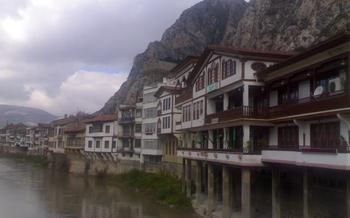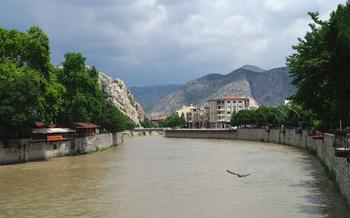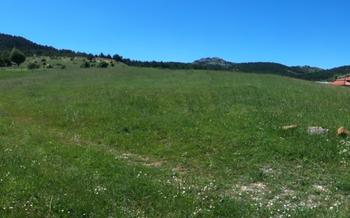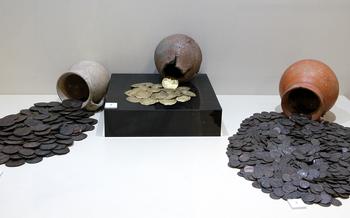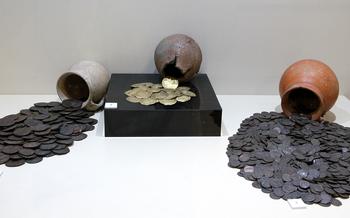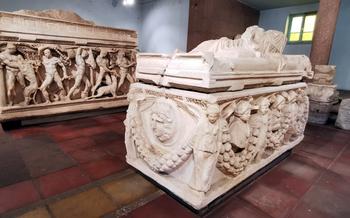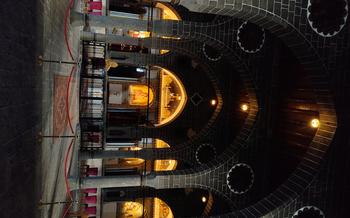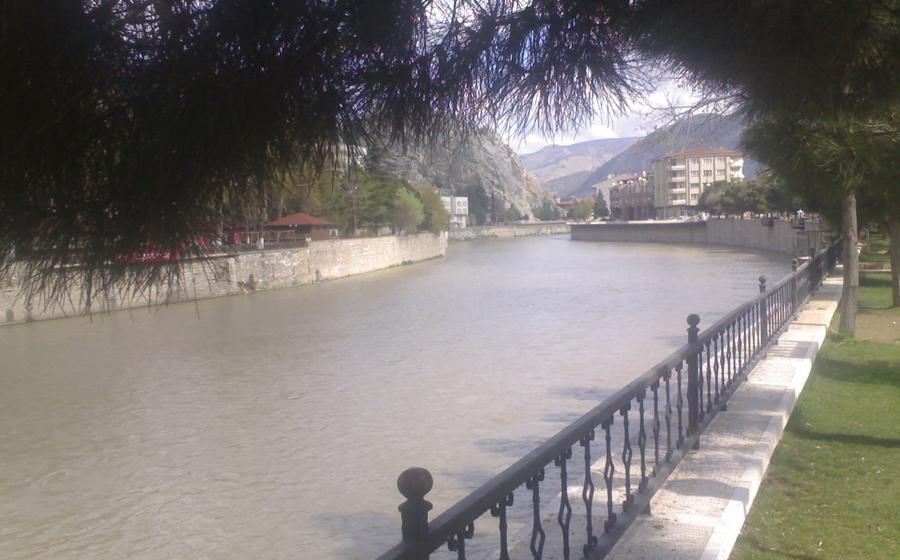
Amasya City Museum
- Amasya City Museum: A Journey Through History
- Exploring the Museum's Collections
- The Hittite Legacy
- The Hellenistic and Roman Periods
- The Byzantine Era
- The Seljuk and Ottoman Periods
- The Ethnographic Section: A Window into Local Traditions
- The Numismatic Collection: A Journey Through Monetary History
- The Manuscripts and Rare Books Section
- Temporary Exhibitions and Events
- Educational Programs and Workshops
- Research Facilities and Publications
- Guided Tours and Audio Guides
- Accessibility and Amenities
- Insider Tip: Hidden Gems of the Museum
Amasya City Museum: A Journey Through History
Amasya City Museum stands as a testament to the rich cultural tapestry that has woven the history of this ancient city. Nestled in the heart of Amasya, the museum invites visitors to embark on a journey through time, exploring the diverse civilizations that have left their indelible mark on this land. Its strategic location, at the crossroads of major trade routes, has facilitated cultural exchange and assimilation, resulting in a fascinating blend of influences that are reflected in the museum's diverse collection.
A striking architectural landmark in its own right, the museum's building is a testament to the city's architectural heritage. Constructed in the 19th century, it seamlessly blends traditional and modern elements, featuring a striking neoclassical façade adorned with intricate carvings and a spacious interior that houses a treasure trove of historical artifacts. The museum's role in preserving and showcasing Amasya's cultural heritage is of paramount importance, as it serves as a repository of knowledge and a source of inspiration for future generations.
Exploring the Museum's Collections
The Amasya City Museum houses a diverse range of artifacts and exhibits that offer a glimpse into the region's rich history and cultural heritage. From prehistoric findings to archaeological treasures, ethnographic displays to Islamic art and calligraphy, the museum's collections are a testament to the vibrant tapestry of civilizations that have shaped Amasya.
Prehistoric artifacts, including stone tools, pottery fragments, and animal bones, provide insights into the earliest human settlements in the region. Archaeological treasures from ancient Hittite, Hellenistic, Roman, and Byzantine sites showcase the city's role as a cultural and commercial hub throughout history.
The ethnographic section of the museum is a treasure trove of local culture and traditions. Traditional costumes, handcrafted items, agricultural tools, and household objects offer a glimpse into the daily life of the people of Amasya. Visitors can learn about local customs, festivals, and beliefs through these immersive displays.
The Islamic art and calligraphy collection is a highlight of the museum, featuring exquisite examples of Islamic calligraphy, illuminated manuscripts, and decorative arts. Visitors can admire the intricate designs, vibrant colors, and spiritual significance of these works, which demonstrate the region's rich Islamic heritage.
The museum's numismatic collection, comprising coins from various periods, provides insights into the economic history of Amasya. Ancient Greek, Roman, Byzantine, and Ottoman coins offer a tangible connection to the region's past and shed light on trade, commerce, and monetary systems.
The Hittite Legacy
Amasya, a city steeped in history, boasts a rich connection to the ancient Hittite civilization. The Amasya City Museum houses a captivating collection of artifacts that transport visitors back to this glorious era. These relics, unearthed from archaeological excavations at nearby Hittite settlements, offer a glimpse into the daily life, religious beliefs, and customs of this enigmatic people.
Among the most notable artifacts are intricately carved stone tablets inscribed with cuneiform script, providing insights into the Hittite language and writing system. Visitors can marvel at the exquisite craftsmanship of bronze figurines, depicting deities, animals, and scenes from everyday life. Clay vessels, tools, and jewelry further enhance our understanding of Hittite domestic life and artistic traditions.
The Hittite period holds immense significance in Turkish history, as it marks the emergence of one of the earliest civilizations in Anatolia. The artifacts displayed in the Amasya City Museum not only showcase the grandeur of the Hittite civilization but also underscore its enduring impact on the cultural heritage of Turkey.
The Hellenistic and Roman Periods
As Greek influence spread eastward following Alexander the Great's conquests, Amasya, with its strategic location, became a significant center of Hellenistic culture. This period saw the construction of impressive structures, including temples, theaters, and gymnasia. The remains of these Hellenistic settlements, such as the monumental tombs and theater foundations, offer glimpses into the city's vibrant past.
The Roman Empire's subsequent rise brought further transformation to Amasya. Under Roman rule, the city flourished as a regional hub of trade and administration. Roman influence can be seen in the well-preserved aqueduct, which once supplied water to the city, as well as in the mosaics, sculptures, and architectural fragments unearthed from Roman settlements.
The Hellenistic and Roman periods in Amasya were marked by cultural exchange and assimilation. Greek and Roman artistic styles, architectural techniques, and religious beliefs blended with local Anatolian traditions, creating a unique cultural tapestry that shaped the city's identity. The artifacts and remains from this era provide valuable insights into the rich cultural heritage of Amasya and its role as a crossroads of civilizations.
The Byzantine Era
The rise of Christianity had a profound impact on Amasya, as the city came under the rule of the Byzantine Empire. During this period, Amasya became a significant center of Christian culture and learning. Numerous churches and monasteries were built throughout the region, serving as places of worship and religious instruction. These architectural marvels showcased Byzantine artistry and craftsmanship, with intricate frescoes, mosaics, and iconography adorning their interiors.
One of the most notable Byzantine churches in Amasya is the Church of the Holy Apostles, which dates back to the 11th century. This well-preserved structure features a domed roof, ornate carvings, and a series of stunning frescoes depicting biblical scenes and the lives of saints. Another important Byzantine site is the Monastery of St. George, located just outside the city. This complex, founded in the 6th century, consists of a church, a refectory, and living quarters for the monks. Visitors can still admire the monastery's impressive frescoes and mosaics, which offer a glimpse into the spiritual life of the Byzantine era.
The Byzantine period left a lasting legacy on Amasya's cultural heritage. The city's churches and monasteries, with their rich artistic traditions, continue to attract visitors and pilgrims from around the world. These sites stand as a testament to the enduring influence of Christianity in the region and provide valuable insights into the Byzantine Empire's cultural and religious heritage.
The Seljuk and Ottoman Periods
The rise of the Seljuk and Ottoman empires marked a significant chapter in Turkish history, leaving an indelible imprint on the architectural landscape of Amasya. The Seljuks, who ruled from the 11th to the 13th centuries, constructed impressive caravanserais, which served as resting places for travelers and traders along the Silk Road. These caravanserais, with their intricate stonework and domed roofs, are a testament to the Seljuk architectural prowess.
The Ottomans, who succeeded the Seljuks, further embellished Amasya with a series of mosques, madrasas, and other architectural masterpieces. The Great Mosque of Amasya, built in the 15th century, stands as a testament to the grandeur of Ottoman architecture. Its elegant minarets, vast courtyard, and intricate tilework reflect the artistic and religious sensibilities of the period.
The blend of Islamic and Anatolian architectural styles in Amasya during the Seljuk and Ottoman periods created a unique and harmonious cityscape. The graceful lines of the Seljuk caravanserais, combined with the imposing domes and minarets of the Ottoman mosques, showcase the rich architectural heritage of this fascinating city.
The Ethnographic Section: A Window into Local Traditions
The Ethnographic Section of the Amasya City Museum offers a rich tapestry of displays that capture the essence of local culture and traditions. Step into this section, and you'll be transported to a world where traditional costumes, handcrafted artifacts, and agricultural tools tell stories of the people of Amasya.
Elaborately embroidered garments, intricately woven carpets, and gleaming copperware showcase the region's vibrant textile and handicraft traditions. Each piece carries a unique story, reflecting the skills and creativity of local artisans. Traditional headwear, jewelry, and footwear provide insights into the region's diverse ethnic groups and their distinct cultural identities.
The museum also houses a collection of agricultural tools that highlight the region's rural heritage. From simple hand tools to more complex machinery, these exhibits illustrate the ingenuity and resourcefulness of the local farmers. Visitors can learn about the traditional farming practices that have shaped the region's landscape and cuisine.
Through interactive displays and informative panels, the Ethnographic Section provides a comprehensive overview of the daily life, customs, and beliefs of the people of Amasya. It's a celebration of the region's rich cultural heritage, preserving and promoting traditions that continue to shape the identity of this vibrant city.
The Numismatic Collection: A Journey Through Monetary History
The Amasya City Museum boasts an extensive numismatic collection, offering visitors a glimpse into the economic and historical significance of coins from various periods. From ancient Greek drachmas to Roman denarii, Byzantine solidi to Ottoman akçe, the museum's coin collection spans centuries and civilizations.
These coins not only serve as a medium of exchange but also tell stories about trade, politics, and cultural interactions. The intricate designs and symbols on the coins provide insights into the artistic styles and beliefs of the time. The collection also includes rare and unique coins, some of which may have been minted in Amasya itself, highlighting the city's role as a regional economic center.
By examining these coins, visitors can trace the evolution of coinage in Amasya and Turkey, understanding how monetary systems have shaped the region's history. The numismatic collection is a valuable resource for scholars and enthusiasts, offering a tangible connection to the past and shedding light on the economic and cultural dynamics of different eras.
The Manuscripts and Rare Books Section
The Amasya City Museum houses a remarkable collection of manuscripts and rare books that offer a glimpse into the intellectual and cultural heritage of the region. Islamic calligraphy, illuminated manuscripts, and historical documents from various periods are carefully preserved and showcased in this section. Visitors can marvel at the intricate artwork, calligraphy, and elaborate scripts that adorn these precious works.
The collection includes Qur'anic manuscripts, religious texts, poetry, historical chronicles, and scientific treatises. Each manuscript tells a unique story, shedding light on the intellectual pursuits, religious beliefs, and literary traditions of past civilizations. The museum's curators have meticulously cataloged and preserved these rare books, ensuring their accessibility to scholars and researchers.
For those interested in Islamic scholarship, the museum's collection of Islamic manuscripts is particularly valuable. These manuscripts provide insights into the development of Islamic theology, philosophy, law, and mysticism. Visitors can admire the beautiful calligraphy and illuminations that adorn these manuscripts, which were often commissioned by wealthy patrons or religious institutions.
The rare books section also features works from the Ottoman period, including official documents, travelogues, and literary texts. These books offer a glimpse into the political, social, and cultural history of the Ottoman Empire. Visitors can learn about the empire's administrative system, its relations with other civilizations, and the literary and artistic achievements of the Ottoman era.
The Amasya City Museum's collection of manuscripts and rare books is a treasure trove for scholars, researchers, and anyone interested in the rich cultural heritage of the region. These precious works provide a tangible connection to the past and offer valuable insights into the intellectual and cultural achievements of past civilizations.
Temporary Exhibitions and Events
The Amasya City Museum regularly hosts temporary exhibitions and events to complement its permanent collection and provide visitors with a diverse and enriching museum experience. These exhibitions cover a wide range of themes, from art and history to culture and heritage.
Art shows featuring local and international artists showcase contemporary artistic expressions and provide a platform for emerging talents. Historical displays delve into specific periods or events in Amasya's rich past, offering visitors a deeper understanding of the city's evolution.
Educational programs and workshops are also organized in collaboration with local institutions and experts. These programs offer interactive learning experiences and hands-on activities, making history and culture accessible and engaging for visitors of all ages.
By hosting temporary exhibitions and events, the Amasya City Museum strives to create a dynamic and vibrant space for cultural exchange, promoting creativity, fostering dialogue, and enriching the visitor experience.
Educational Programs and Workshops
The Amasya City Museum goes beyond being a mere repository of artifacts and exhibits. It actively engages in educational initiatives and workshops, designed to cater to a wide range of audiences, from students to adults. These programs aim to foster cultural awareness, appreciation, and understanding among visitors of all ages.
One of the highlights of the museum's educational offerings is its interactive workshops. These hands-on sessions provide participants with an opportunity to delve deeper into specific aspects of Amasya's rich history and culture. Participants can engage in art workshops, where they can create their own replicas of ancient artifacts or learn traditional crafts like pottery or weaving. History workshops offer insights into the region's past, allowing participants to explore archaeological techniques or decipher ancient scripts.
The museum also hosts educational programs tailored specifically for school groups. These programs are designed to align with school curricula, providing students with a dynamic and engaging learning experience. Guided tours, interactive activities, and hands-on workshops bring history and culture to life, fostering a deeper appreciation for Amasya's heritage among the younger generation.
By incorporating educational programs and workshops into its offerings, the Amasya City Museum not only preserves and showcases cultural heritage but also actively promotes its significance and relevance to contemporary society. These initiatives cultivate a sense of cultural pride and foster a lifelong passion for learning and exploration.
Research Facilities and Publications
The Amasya City Museum is not only a place to showcase artifacts and exhibits but also a hub for research and scholarship. It houses a well-equipped library and research facilities, providing access to a vast collection of books, journals, and archival materials. Scholars and researchers can delve into the museum's collection for academic purposes, conducting in-depth studies on various aspects of Amasya's history and culture.
The museum actively supports research and publication, facilitating the dissemination of knowledge and understanding. It publishes research papers, monographs, and books based on the museum's collection and the work of its researchers. These publications contribute to the advancement of historical knowledge, shedding light on Amasya's rich past and its significance in the broader context of Turkish and Anatolian history.
By providing research facilities and supporting publications, the Amasya City Museum plays a crucial role in promoting historical research and fostering a deeper understanding of the region's cultural heritage.
Guided Tours and Audio Guides
To fully appreciate the richness and depth of the Amasya City Museum's collection, guided tours are highly recommended. Knowledgeable and passionate guides lead visitors through the various exhibits, providing insightful commentary and historical context. Tours are available in multiple languages, ensuring that international visitors can also benefit from this enriching experience.
For those who prefer a self-guided tour, audio guides are available. These devices offer detailed information on each exhibit, allowing visitors to explore the museum at their own pace and focus on the aspects that particularly interest them. Whether you opt for a guided tour or an audio guide, you'll gain a deeper understanding of Amasya's rich history and cultural heritage.
Accessibility and Amenities
The Amasya City Museum is committed to providing an inclusive and welcoming environment for all visitors, ensuring that everyone can enjoy and appreciate its rich cultural heritage. Accessibility is a top priority, with wheelchair ramps and elevators installed throughout the museum to facilitate easy movement for visitors with disabilities. Restrooms are conveniently located on each floor, and seating areas are provided for those who need a moment to rest or contemplate the exhibits. Drinking fountains are also available to quench your thirst as you explore the museum's treasures. To enhance your visit further, the museum offers a range of amenities, including a well-stocked museum shop where you can purchase souvenirs, books, and educational materials to remember your visit. Whether you're looking for a unique gift or a memento of your time in Amasya, the museum shop has something for everyone.
Insider Tip: Hidden Gems of the Museum
Rooftop Terrace: Ascend to the museum's rooftop terrace for a breathtaking panorama of Amasya. Take in the city's iconic landmarks, including the Green Mosque and the rock-cut tombs, all set against the backdrop of the meandering Yeşilırmak River.
Museum Garden: Seek solace in the tranquil embrace of the museum's garden, a hidden oasis amidst the bustling city. Stroll through the verdant paths, admire the colorful blooms, and find a secluded spot for contemplation or a picnic.
Cultural Events and Workshops: Immerse yourself in Amasya's rich culture by attending one of the museum's captivating events or workshops. Learn traditional crafts, witness live performances, or engage in hands-on activities that bring the museum's collection to life.


